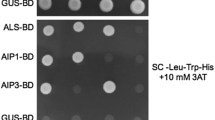Abstract
To study the regulation of lysine and threonine metabolism in plants, we have transformed Arabidopsis thaliana with chimeric genes encoding the two bacterial enzymes dihydrodipicolinate synthase (DHPS) and aspartate kinase (AK). These bacterial enzymes are much less sensitive to feedback inhibition by lysine and threonine than their plant counterparts. Transgenic plants expressing the bacterial DHPS overproduced lysine, but lysine levels were quite variable within and between transgenic genotypes and there was no direct correlation between the levels of free lysine and the activity of DHPS. The most lysine-overproducing plants also exhibited abnormal phenotypes. However, these phenotypes were detected only at early stages of plant growth, while at later stages, new buds emerged that looked completely normal and set seeds. Wild-type plants exhibited relatively high levels of free threonine, suggesting that in Arabidopsis AK regulation may be more relaxed than in other plants. This was also supported by the fact that expression of the bacterial AK did not cause any dramatic elevation in this amino acid. Yet, the relaxed regulation of threonine synthesis in Arabidopsis was not simply due to a reduced sensitivity of the endogenous AK to feedback inhibition by lysine and threonine because growth of wild-type plants, but not of transgenic plants expressing the bacterial AK, was arrested in media containing these two amino acids. The present results, combined with previous studies from our laboratory, suggest that the regulation of lysine and threonine metabolism is highly variable among plant species and is subject to complex biochemical, physiological and environmental controls. The suitability of these transgenic Arabidopsis plants for molecular and genetic dissection of lysine and threonine metabolism is also discussed.
Similar content being viewed by others
References
An G: Development of plant promoter expression vectors and their use for analysis of differential activity of nopaline synthase promoter in transformed tobacco cells. Plant Physiol 81: 86–91 (1986).
Bieleski RL, Turner NA: Separation and estimation of aminoacids in crude plant extracts by thin-layer electrophoresis and chromatography. Anal Biochem 17: 278–293 (1966).
Black S, Wright NG: β-aspartokinase and β-aspartyl phosphate. J Biol Chem 213: 27–38 (1955).
Bradford MM: A rapid and sensitive method for the quantiation of microgram quantities of protein utilizing the principle of protein dye binding. Anal Biochem 72: 248–254 (1976).
Bryan JK: Synthesis of the aspartate family and branched-chain amino acids. In: Miflin BJ (ed) The Biochemistry of Plants, vol 5, pp. 403–452. Academic Press, New York (1980).
Fluhr R, Moses P, Morelli G, Coruzzi G, Chua N-H: Expression dynamics of the pea rbcS family and organ distribution of the transcripts. EMBO J 5: 2063–2071 (1986).
Galili G: Regulation of lysine and threonine synthesis. Plant Cell 7: 899–906 (1995).
Galili G, Shaul O, Perl A, Karchi H: Synthesis and accumulation of the essential amino acids lysine and threonine in seeds. In: Kigel H, Galili G (eds) Seed Development and Germination, pp. 811–831. Marcel Dekker, New York (1994).
Gallie DR, Lucas WJ, Walbot V: Visualizing mRNA expression in plant protoplasts: Factors influencing efficient mRNA uptake and translation. Plant Cell 1: 301–311 (1989).
Greve HD, Dhaese P, Seurinck J, Lemmers M, VanMontagu M, Schell J: Nucleotide sequence and transcript map of the Agrobacterium tumefaciens Ti plasmid-encoded octopine synthase gene. J Mol Appl Genet 1: 499–511 (1983).
Hockema A, Hirsch P, J. HP, A. SR: A binary plant vector strategy based on separation of vir-and T-region of the Agrobacterium tumefaciens Ti plasmid. Nature 303: 179–180 (1983).
Hood EE, Helmer GL, Fraley RT, Chilton M: The hypervirulence of Agrobacterium tumefaciens A281 is encoded in a region of pTiBo542 outside of T-DNA. J Bact 168: 1291–1301 (1986).
Hurst WJ: O-phthaldehyde derivative of amino acids in cocoa beans. In: Hancock WS (ed) CRC Handbook of HPLC for the Separation of Amino Acids, Peptides and Proteins, vol 1, pp. 325–330. CRC Press, Boca Raton, FL (1984).
Jacobs M, Negrutiu I, Dirks R, Cammaerts D: Selection programs for isolation and analysis of mutants in plant cell cultures. In: Green CE, Somers DA, Hackett WP, Biesboer DD (eds) Plant Biology, vol 3, pp. 243–264. Alan R. Liss, New York (1987).
Karchi H, Shaul O, Galili G: Seed specific expression of a bacterial desensitized aspartate kinase increases the production of seed threonine and methionine in transgenic tobacco. Plant J 3: 721–727 (1993).
Karchi H, Shaul O, Galili G: Lysine synthesis and catabolism are coordinately regulated during tobacco seed development. Proc Natl Acad Sci USA 91: 2577–2581 (1994).
Laemmli UK: Cleavage of structural proteins during the assembly of the head of bacteriophage T4. Nature 227: 680–685 (1970).
Marton L, Browse J: Facile transformation of Arabidopsis. Plant Cell Rep 10: 235–239 (1991).
Negrutiu I, Cattoir-Reynearts A, Verbruggen I, Jacobs M: Lysine overproducer mutants with an altered dihydrodipicolinate synthase from protoplast culture of Nicotiana sylvestris (Spegazzini and Comes). Theor Appl Genet 68: 11–20 (1984).
Perl A, Shaul O, Galili G: Regulation of lysine synthesis in transgenic potato plants expressing a bacterial dihydrodipicolinate synthase in their chloroplasts. Plant Mol Biol 19: 815–823 (1992).
Shaul O, Galili G: Increased lysine synthesis in transgenic tobacco plants expressing a bacterial dihydrodipicolinate synthase in their chloroplasts. Plant J 2: 203–209 (1992).
Shaul O, Galili G: Threonine overproduction in transgenic tobacco plants expressing a mutant desensitized aspartate kinase from Escherichia coli. Plant Physiol 100: 1157–1163 (1992).
Shaul O, Galili G: Concerted regulation of lysine and threonine synthesis in tobacco plants expressing bacterial feedback-insensitive aspartate kinase and dihydrodipicolinate synthase. Plant Mol Biol 23: 759–768 (1993).
Yugari Y, Gilvarg C: The condensation step in diaminopimelate synthesis. J Biol Chem 240: 4710–4716 (1965).
Author information
Authors and Affiliations
Rights and permissions
About this article
Cite this article
Tzchori, I.BT., Perl, A. & Galili, G. Lysine and threonine metabolism are subject to complex patterns of regulation in Arabidopsis . Plant Mol Biol 32, 727–734 (1996). https://doi.org/10.1007/BF00020213
Received:
Accepted:
Issue Date:
DOI: https://doi.org/10.1007/BF00020213




